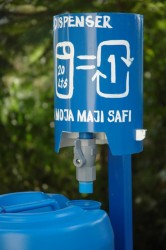Although droughts are often recognized for their impact on crops and food prices, the human effect caused by these natural disasters can be serious and long-lasting. Today’s post by Charlotte Kellogg, a writer and researcher at http://www.publichealthdegree.com/, delves into the ways that droughts can lead to severe, but often preventable, public health crises. Included in these crises is the contamination of water, an issue that can be addressed with innovative and site-appropriate tools, as noted in the WASHplus blog earlier this year.
The Problem Drought Presents to Public Health

Photo source: USAID
All natural disasters pose health risks to survivors, but perhaps none as profoundly as droughts. The worst droughts last for months if not longer, and the toll on humans and animals both is often drawn out and painful. Starvation, malnutrition, and chronic dehydration take a long time to set in, and even longer to reverse. Illnesses transmitted during these periods are sometimes quick to take lives, but more often are latent, causing problems years down the road. Improved infrastructure and planning technologies have allowed government entities and aid organizations to better their responses to droughts. More improvements are on the horizon, with the hope that the suffering caused by suffering may not always be the urgent health crisis it has been in the past.
Simply speaking, a drought is an environmental condition where there is a serious shortage of water. This is often caused by lack of rainfall, but poor irrigation and overuse of streambeds and lakes can also contribute. Many of the most severe droughts happen in the desert climates of Africa, where water is scarce to start with and many communities do not have adequate means of capturing and storing rainfall when they do come. It’s important to remember that severely dry conditions can happen in almost any region, however. The Midwestern United States, a prime corn growing region, has seen serious drought conditions this year, which has weakened the corn yield—and with it, many aspects of the local economy.
Contaminated Water
One of the biggest public health risks of any drought is contaminated water. When the ground becomes dry and parched, wells and springs often dry up, which can severely limit the availability of clean drinking water. In industrialized societies, the biggest problem is often with sewage backup or plumbing failures. “Pressure fluctuations and water outages create ideal conditions for contamination through a phenomenon known as backflow,” the University of Washington School of Public Health and Community Medicine said in a 2001 article examining the effects of drought on communities in Washington State. “Backflow” is a condition where untreated water filters back into pipes that normally carry clean or purified water into homes.
In less-developed communities, the risks of water contamination are much more acute. Very dry conditions often accelerate the rate at which raw sewage enters into the water supply, and wells dug improperly often tap water that is unfit for consumption. Any pools of water that exist also become breeding grounds for insects and other disease-carrying pests.
Communicable Diseases
Hand-in-hand with water contamination is the risk of communicable disease. “Lack of water supply and sanitation services, malnutrition, displacement and higher vulnerability of the population all increase the risk of infectious diseases such as cholera, typhoid fever, diarrhea, acute respiratory infections and measles,” the World Health Organization says. Many of these diseases are exacerbated by dehydration and overheating, two conditions common during droughts.
Starvation and Malnutrition
When water dries up, crops tend to die and livestock loses vitality. This often has profound impacts on the health and well-being of affected populations, particularly children. Young people who do not get enough protein or essential nutrients like vitamin complexes early in life often suffer debilitating consequences later on, regardless of future access to food and water. Weak bones, chronic pain, and stunted growth are only some of the concerns associated with starvation and malnutrition.
It is all but impossible to prevent droughts, as they are usually caused by weather patterns that are out of human control. A lot can be done to mitigate negative health effects, however, including reliance on advanced prediction technologies and the use of cellphones and mobile applications to more effectively bring aid to affected regions. In many cases, simple pre-planning and government readiness with an eye toward understanding the risks is all it takes to help populations weather drought conditions unscathed.





